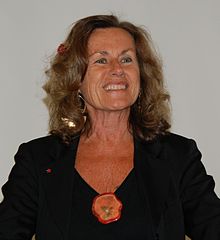Underground (1976 film)
Underground is a 1976 documentary film about the Weathermen, founded as a militant faction of the Students for a Democratic Society SDS, who fought to overthrow the U.S. government during the 1960s and 1970s. The film consists of interviews with members of the group after they went underground and footage of the antiwar and civil rights protests of the time. It was directed by Emile de Antonio, Haskell Wexler and Mary Lampson, later subpoenaed by the Federal Bureau of Investigation in an attempt to confiscate the film footage in order to gain information that would help them arrest the Weathermen.
This film is informed by the political and social unrest of the 1960s in the United States. The civil rights movement, Vietnam War and subsequent antiwar movement, McCarthyism, unemployment and urban decay, and liberation struggles across many nations not only played into the creation of the Weather Underground, but also were a significant factor in Emile de Antonios decision to use them as the focus of his film. It was made in 1975, following the groups involvement in bombing the Pentagon, and an accident at their Greenwich Village townhouse in which a bomb exploded prematurely, killing three Weathermen and driving the rest underground. Emile de Antonio attributes his decision to make this film to his own Marxist beliefs, his fascination with the political climate of the 60s and 70s, and his specific interest in the Weather Underground after reading their manifesto Prairie Fire Rosenthal, 1978. He made contact with the group, and after gaining their consent to take part in the project enlisted Mary Lampson with whom he had worked in the past, and Haskell Wexler an established cinematographer with leftist sympathies. The three raised the money and put the film together themselves. The Weathermen agreed to participate on the condition that the filmmakers would not contact them again after the films completion Paletz, 1977.The situation of the Weatherman as fugitives wanted by the FBI necessitated an unconventional style in conducting their interviews. The footage was filmed in only three days, and Wexler shot the participants from behind or through a screen in order to conceal their individual identities. The film is unique in that the viewer is able to see the filmmakers but not the subjects themselves. The interactions between the Weathermen and filmmakers raise many questions about the role of documentary film and the contrived nature of its setups. This is apparent at several points in the film where the Weathermen express concern over the filmmakers catching th
Source: Wikipedia


